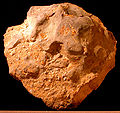Carbonate hardgrounds
Carbonate hardgrounds are surfaces of synsedimentarily cemented carbonate layers that have been exposed on the
Carbonate hardgrounds often host a unique fauna and flora adapted to the hard surface. Organisms usually cement themselves to the substrate and live as sessile filter-feeders (Brett and Liddell, 1982). Some bore into the cemented carbonate to make protective domiciles (borings) for filter-feeding. Sometimes hardgrounds are undermined by currents which remove the soft sediment below them, producing shallow cavities and caves which host a cryptic fauna (Palmer and Fürsich, 1974). The evolution of hardground faunas can be traced through the Phanerozoic, from the Cambrian Period to today (Taylor and Wilson, 2003).

Carbonate hardgrounds were most commonly formed during
Stratigraphers and sedimentologists often use hardgrounds as
-
Hardground in the Liberty Formation (Upper Ordovician) of southern Ohio.
-
Cross-section of an Upper Ordovician hardground from Kentucky. The light-colored vertical elements are borings (Trypanites) filled with dolomite. The scale bar is 1.0 cm.
-
A Middle Ordovician hardground from the Kanosh Formation of Utah with echinoderm holdfasts cemented to its upper surface. The scale bar is 1.0 cm.
-
Petroxestes borings in an Upper Ordovician hardground, southern Ohio.
-
Trypanites borings in an Upper Ordovician hardground, Indiana.
-
Carbonate hardground with an encrustingMiddle Ordovician) of Utah; scale in mm.
-
Cross-section of a carbonate hardground encrusted by oysters and bored by bivalves (Gastrochaenolites); Carmel Formation (Middle Jurassic) of southern Utah.
-
Trypanites borings in an Upper Ordovician hardground from northern Kentucky.
-
Carbonate hardground; Ora Formation, Upper Cretaceous (Turonian), southern Israel.
References
- Bodenbender, B.E.; Wilson, M.A.; Palmer, T.J. (1989). "Paleoecology of Sphenothallus on an Upper Ordovician hardground". Lethaia. 22 (2): 217–225. .
- Brett, C.E.; Liddell, W.D. (1981). "Preservation and paleoecology of a Middle Ordovician hardground community". Paleobiology. 4 (3): 329–348. S2CID 52255847.
- Fürsich F.T., Kennedy, W.J., Palmer, T.J. (1981). "Trace fossils at a regional discontinuity surface: the Austin/Taylor (Upper Cretaceous) contact in central Texas". Journal of Paleontology. 55: 537–551.
{{cite journal}}: CS1 maint: multiple names: authors list (link) - Fürsich, F.T.; Oschmann, W.; Singh, B.; Jaitly, A.K. (1992). "Hardgrounds, reworked concretion levels and condensed horizons in the Jurassic of western India: their significance for basin analysis". Journal of the Geological Society of London. 149 (3): 313–331. S2CID 130374753.
- Malpas, J.A.; Gawthorpe, R. L.; Pollard, J.E.; Sharp, I.R. (2004). "Ichnofabric analysis of the shallow marine Nukhul Formation (Miocene), Suez Rift, Egypt: implications for depositional processes and sequence stratigraphic evolution". Palaeogeography, Palaeoclimatology, Palaeoecology. 215 (3–4): 239–264. .
- Palmer, T.J. Fürsich, F.T. (1974). "The ecology of a Middle Jurassic hardground and crevice fauna". Palaeontology. 17: 507–524.
{{cite journal}}: CS1 maint: multiple names: authors list (link) - Palmer, T.J.; Palmer, C.D. (1977). "Faunal distribution and colonization strategy in a Middle Ordovician hardground community". Lethaia. 10 (3): 179–199. .
- Palmer, T.J.; Wilson, M.A. (2004). "Calcite precipitation and dissolution of biogenic aragonite in shallow Ordovician calcite seas". Lethaia. 37 (4): 417–427. .
- Palmer, T.J. (1978). "Burrows at certain omission surfaces in the Middle Ordovician of the Upper Mississippi Valley". Journal of Paleontology. 52: 109–117.
- Palmer, T.J. (1982). "Cambrian to Cretaceous changes in hardground communities". Lethaia. 15 (4): 309–323. .
- Pope, M.C.; Read, J.F. (1997). "High-resolution surface and subsurface sequence stratigraphy of the Middle to Late Ordovician (late Mohawkian-Cincinnatian) foreland basin rocks, Kentucky and Virginia". AAPG Bulletin. 81: 1866–1893. .
- Taylor, P.D.; Wilson, M.A. (2003). "Palaeoecology and evolution of marine hard substrate communities" (PDF). Earth-Science Reviews. 62 (1–2): 1–103. .
- Vinn, O.; Wilson, M.A. (2010). "Microconchid-dominated hardground association from the late Pridoli (Silurian) of Saaremaa, Estonia". Palaeontologia Electronica. 2010 (2): 13.2.9A. Retrieved 2012-09-16.
- Vinn, O.; Toom, U. (2015). "Some encrusted hardgrounds from the Ordovician of Estonia (Baltica)". Carnets de Géologie. 15 (7): 63–70. .
- Wilson, M.A.; Palmer, T.J. (1992). "Hardgrounds and hardground faunas". University of Wales, Aberystwyth, Institute of Earth Studies Publications. 9: 1–131.
- Wilson, M.A.; Wolfe, K.R.; Avni, Y. (2005). "Development of a Jurassic rocky shore complex (Zohar Formation, Makhtesh Qatan, southern Israel)" (PDF). Israel Journal of Earth Sciences. 54 (3): 171–178. doi:10.1560/71EQ-CNDF-K3MQ-XYTA (inactive 31 January 2024).)
{{cite journal}}: CS1 maint: DOI inactive as of January 2024 (link
Further reading
- Vinn, O. (2015). "Sparsely encrusted hardground in the Darriwilian calcareous sandstone of Cape Pakri, NW Estonia (Baltica)" (PDF). Estonian Journal of Earth Sciences. 64: 249–253. . Retrieved 2015-09-23.
- Vinn, O.; Wilson, M.A. (2010). "Early large borings from a hardground of Floian-Dapingian age (Early and Middle Ordovician) in northeastern Estonia (Baltica)". Carnets de Géologie. 2010: CG2010_L04. .
- Vinn, O.; Wilson, M.A.; Toom, U. (2015). "Bioerosion of Inorganic Hard Substrates in the Ordovician of Estonia (Baltica)". PLOS ONE. 10 (7): e0134279. PMID 26218582.
- Vinn, O.; Toom, U. (2016). "A sparsely encrusted hardground with abundant Trypanites borings from the Llandovery of the Velise River, western Estonia (Baltica)" (PDF). Estonian Journal of Earth Sciences. 65: 19–26. . Retrieved 2016-03-05.









